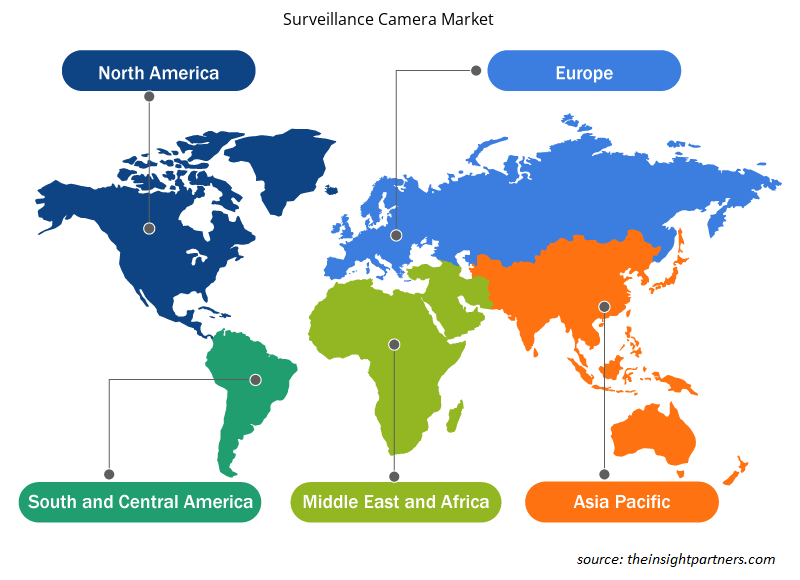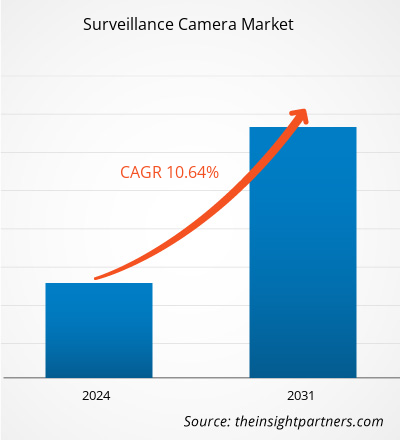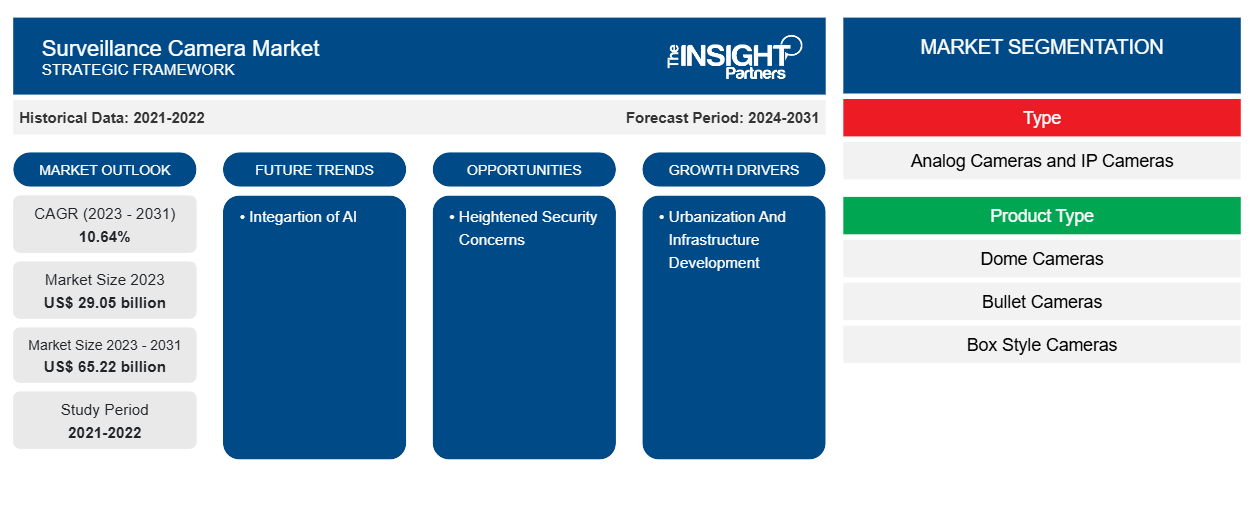감시 카메라 시장 규모는 2023년 290억 5천만 달러에서 2031년 652억 2천만 달러로 성장할 것으로 예상됩니다. 이 시장은 2023~2031년에 10.64%의 CAGR을 기록할 것으로 예상됩니다. 증가하는 보안 우려가 글로벌 감시 카메라 시장을 주도합니다.
감시 카메라 시장 분석
감시 카메라의 전체 네트워크는 특정 부동산을 모니터링하고 제어하는 데 사용되는 폐쇄 회로 시스템으로 구성됩니다. 이러한 카메라는 종종 원격 위치에서 주요 위치로 감시 카메라를 연결하는 IP(인터넷 프로토콜) 네트워크에서 작동합니다. 감시 또는 보안 카메라는 단일 PoE 케이블을 통해 녹화된 비디오를 디지털 신호 형태로 NVR(네트워크 비디오 레코더)로 전송하여 전원 케이블이 필요하지 않습니다.
감시 카메라 시장 개요
감시 카메라는 설치된 지역을 모니터링하는 카메라입니다. 이 카메라는 보안 시스템과 함께 작동합니다. 이 카메라는 사무실, 가정, 소매점 또는 공공 장소에 설치하여 보안을 보장하고 범죄 행위를 억제할 수 있습니다. 이 카메라의 녹화된 영상은 범죄 발생 시 증거로 사용됩니다. 다양한 유형의 기능을 갖춘 다양한 유형의 보안 카메라를 찾을 수 있습니다. 감시 카메라는 특정 지역을 모니터링하고 원치 않는 상황을 제어하는 데 더 잘 사용됩니다. 감시 카메라는 범죄 활동이 발생할 때 당국에 경보를 울리도록 설계되었습니다. AI와 통합되었지만 보안 카메라 는 영상을 녹화하는 카메라일 뿐입니다.
귀하의 요구 사항에 맞게 이 보고서를 사용자 정의하세요
이 보고서의 일부 또는 국가 수준 분석, Excel 데이터 팩을 포함하여 모든 보고서에 대한 사용자 정의를 무료로 받을 수 있으며 신생 기업 및 대학을 위한 훌륭한 혜택과 할인 혜택을 이용할 수 있습니다.
-
이 보고서의 주요 시장 동향을 알아보세요.이 무료 샘플에는 시장 동향부터 추정 및 예측까지 다양한 데이터 분석이 포함됩니다.
감시 카메라 시장 동인 및 기회
도시화와 인프라 개발은 시장을 선호합니다
감시 기술은 도시 인프라와 서비스를 최적화하는 데 중요한 역할을 합니다. 센서와 카메라는 교통 관리, 에너지 소비 최적화, 폐기물 관리 및 더 나은 교통 시스템 개발을 지원하는 데이터를 제공합니다. 이러한 통찰력은 정보에 입각한 도시 계획을 용이하게 하여 자원 효율적이고 지속 가능한 도시로 이어집니다. 또한 스마트 시티 의 통합 감시 카메라 시스템은 주민의 안전과 보안을 보장하는 데 탁월한 능력을 제공합니다. 실시간 모니터링은 비상 상황에 대한 신속한 대응, 이상 징후의 적시 감지 및 이벤트 또는 위기 동안의 효과적인 군중 관리를 용이하게 합니다. 따라서 도시화와 인프라 개발은 감시 카메라 시장의 성장을 촉진하고 있습니다.
높아진 보안 우려
카메라, 비디오 모니터링 시스템 및 상호 운용성 플랫폼은 공공 안전 문제로 인해 그 어느 때보다 더 많은 주목을 받고 있습니다. 더 많은 카메라를 설치하고 비디오 감시 시스템을 개선하려는 최우선 순위의 경쟁은 그 어느 때보다 큽니다. 다양한 국가에서 보안 목적으로 감시 카메라를 배치하고 있습니다. 예를 들어, 2024년 2월, 러시아의 우크라이나 본격 침공이 2년차를 맞이하면서 우크라이나 전역의 정부 운영 보안 시스템, 주택 및 민간 기업에서 사용하는 수십만 대의 중국산 Hikvision 및 Dahua 비디오 감시 카메라가 러시아 군대의 공격 위험을 높이고 있다고 우크라이나 디지털 보안 전문가와 정부 관리들은 우려하고 있습니다. 따라서 보안에 대한 우려가 커지면서 감시 카메라 시장이 성장할 기회가 생깁니다.
감시 카메라 시장 보고서 세분화 분석
감시 카메라 시장 분석에 기여한 주요 세그먼트는 유형, 제품 유형 및 최종 사용자입니다.
- 감시 카메라 시장은 유형에 따라 아날로그 카메라와 IP 카메라로 구분됩니다.
- 감시 카메라 시장은 제품 유형에 따라 돔 카메라, 총알형 카메라, 박스형 카메라, PTZ 카메라, 열화상 카메라 등으로 구분됩니다.
- 감시 카메라 시장은 최종 사용자를 기준으로 BFSI, 정부 및 국방, 상업, 제조 및 건설, 의료, 물류 및 운송, 주거 및 기타로 구분됩니다.
지역별 감시 카메라 시장 점유율 분석
감시 카메라 시장 보고서의 지리적 범위는 주로 북미, 아시아 태평양, 유럽, 중동 및 아프리카, 남미/남중부 아메리카의 5개 지역으로 나뉩니다. 북미에는 다양한 감시 카메라 공급업체가 있습니다. 플레이어는 CCTV Security Pro와 기타입니다. 또한 미국은 엄격한 감시를 받고 있습니다. 애틀랜타만 해도 1,000명당 50대의 CCTV 카메라가 있습니다. 따라서 이러한 사례가 감시 카메라 시장의 성장을 촉진합니다.
감시 카메라 시장 지역 통찰력
Insight Partners의 분석가들은 예측 기간 동안 감시 카메라 시장에 영향을 미치는 지역적 추세와 요인을 철저히 설명했습니다. 이 섹션에서는 북미, 유럽, 아시아 태평양, 중동 및 아프리카, 남미 및 중미의 감시 카메라 시장 세그먼트와 지리에 대해서도 설명합니다.

- 감시 카메라 시장에 대한 지역별 특정 데이터를 얻으세요
감시 카메라 시장 보고서 범위
| 보고서 속성 | 세부 |
|---|---|
| 2023년 시장 규모 | 290억 5천만 달러 |
| 2031년까지 시장 규모 | 652억 2천만 달러 |
| 글로벌 CAGR (2023-2031) | 10.64% |
| 역사적 데이터 | 2021-2022 |
| 예측 기간 | 2024-2031 |
| 다루는 세그먼트 |
유형별로
|
| 포함된 지역 및 국가 |
북아메리카
|
| 시장 선도 기업 및 주요 회사 프로필 |
|
시장 참여자 밀도: 비즈니스 역학에 미치는 영향 이해
감시 카메라 시장은 소비자 선호도의 변화, 기술 발전, 제품의 이점에 대한 인식 증가와 같은 요인으로 인해 최종 사용자 수요가 증가함에 따라 빠르게 성장하고 있습니다. 수요가 증가함에 따라 기업은 제품을 확장하고, 소비자의 요구를 충족하기 위해 혁신하고, 새로운 트렌드를 활용하여 시장 성장을 더욱 촉진하고 있습니다.
시장 참여자 밀도는 특정 시장이나 산업 내에서 운영되는 회사나 기업의 분포를 말합니다. 주어진 시장 공간에 얼마나 많은 경쟁자(시장 참여자)가 존재하는지 그 규모나 전체 시장 가치에 비해 나타냅니다.
감시 카메라 시장에서 활동하는 주요 회사는 다음과 같습니다.
- 캐논 주식회사
- 다화테크놀로지 주식회사
- 플리어 시스템 주식회사
- 항저우 히크비전 디지털 테크놀로지 유한회사
- 한화테크윈(주)
- 허니웰 인터내셔널 주식회사
면책 조항 : 위에 나열된 회사는 어떤 특별한 순서에 따라 순위가 매겨지지 않았습니다.

- 감시 카메라 시장 주요 주요 업체 개요를 알아보세요
감시 카메라 시장 뉴스 및 최근 개발
감시 카메라 시장은 1차 및 2차 조사 이후의 질적, 양적 데이터를 수집하여 평가합니다. 여기에는 중요한 기업 간행물, 협회 데이터 및 데이터베이스가 포함됩니다. 다음은 시장의 개발 목록입니다.
- 2024년 1월, IT, 전자 및 홈 엔터테인먼트 산업을 대상으로 하는 제품인 Consistent Infosystems는 인도에서 Made in India 감시 카메라의 새로운 제품군을 출시하여 이미 강력한 보안 및 감시 제품 포트폴리오를 강화했습니다. 새로운 감시 카메라 제품군은 완벽한 감시 솔루션을 제공합니다. 여기에는 Smart Wireless 4G PT 카메라, 4G Solar 카메라, Wireless Pan-Tilt Wifi 3MP/4MP Mini wifi P2P Plug and Play Hassle Free, 4G 카메라 컬러 카메라 및 CCTV 카메라 4G Dome이 포함됩니다.
(출처: Consistent Infosystems, 회사 웹사이트, 2021)
- 2023년 2월, Idis는 다양한 엣지 AI 카메라를 출시했습니다. 새로운 카메라는 자체 개발한 Idis 딥 러닝 엔진의 확장 가능한 사용을 확장하여 AI 기반 서버, 어플라이언스 및 소프트웨어를 통해 안전, 보안 및 운영 요구 사항을 충족하는 데 중점을 두고 구축되어 다양한 수직 시장에서 모든 규모의 조직에 적합합니다.
(출처: Idis, 회사 웹사이트, 2023)
감시 카메라 시장 보고서 범위 및 제공물
"감시 카메라 시장 규모 및 예측(2021-2031)" 보고서는 아래 영역을 포괄하는 시장에 대한 자세한 분석을 제공합니다.
- 범위에 포함된 모든 주요 시장 세그먼트에 대한 글로벌, 지역 및 국가 수준의 시장 규모 및 예측
- 동인, 제약 및 주요 기회와 같은 시장 역학
- 주요 미래 트렌드
- 자세한 PEST/포터의 5가지 힘과 SWOT 분석
- 주요 시장 동향, 주요 업체, 규정 및 최근 시장 동향을 포괄하는 글로벌 및 지역 시장 분석
- 시장 집중도, 히트맵 분석, 유명 기업 및 최근 개발 사항을 포함하는 산업 환경 및 경쟁 분석
- 자세한 회사 프로필
- 과거 분석(2년), 기준 연도, CAGR을 포함한 예측(7년)
- PEST 및 SWOT 분석
- 시장 규모 가치/거래량 - 글로벌, 지역, 국가
- 산업 및 경쟁 환경
- Excel 데이터세트
최근 보고서
관련 보고서
사용 후기
구매 이유
- 정보에 기반한 의사 결정
- 시장 역학 이해
- 경쟁 분석
- 고객 인사이트
- 시장 예측
- 위험 완화
- 전략 기획
- 투자 타당성 분석
- 신흥 시장 파악
- 마케팅 전략 강화
- 운영 효율성 향상
- 규제 동향에 발맞춰 대응























 무료 샘플 받기 - 감시 카메라 시장
무료 샘플 받기 - 감시 카메라 시장